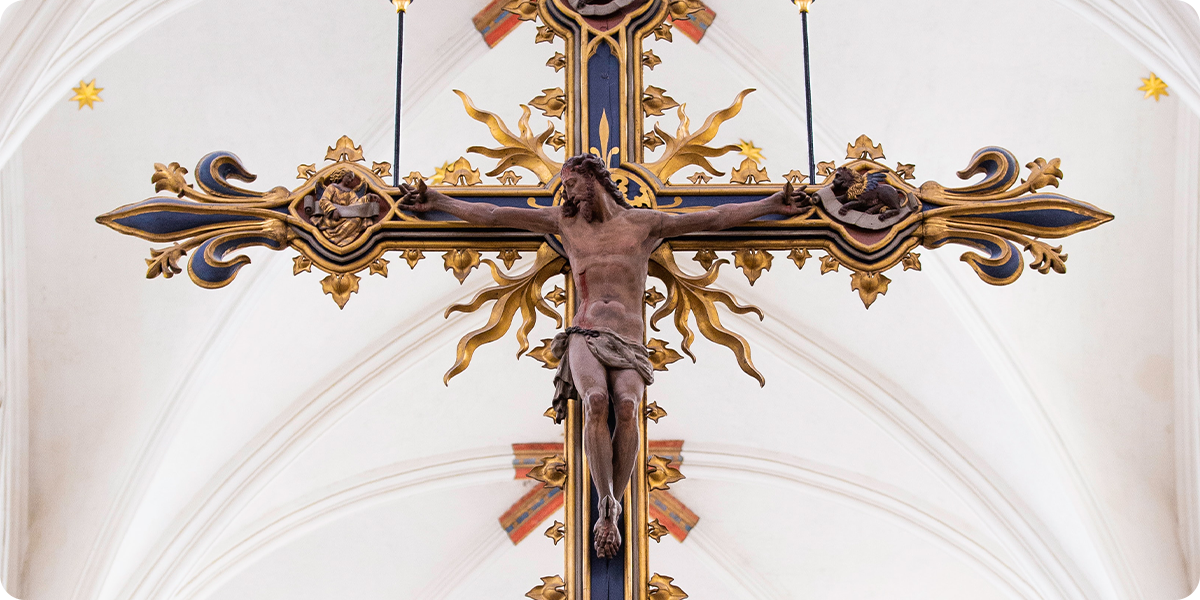

After the Creed and Intercessions, for which we used a standing posture of prayer, we sit down while the preparations for the Liturgy of the Eucharist take place. As the Diocese of Peoria teaches, “Before Jesus sat down with his disciples to celebrate the Last Supper, he instructed that various preparations be made. Preparations such as securing and preparing a room, making bread and purchasing wine all needed to be done before this sacred event could take place. The same is true when we celebrate Mass… Typically, there is music during the preparations—either instrumental, by the choir, or a common hymn. The music at this point should assist in our proximate preparation for the Liturgy of the Eucharist” (“A Study of the Mass,” p. 11). Since we are about to participate in the celebration of the Lord’s Supper, music can help us be more prayerfully prepared and in the right mindset. Have you ever noticed that songs at this point in the Mass are often slower in tempo and more flowing in words? No doubt, this is to help prepare us for the Liturgy of the Eucharist. Singing and listening to meditation-type music can help us prepare to pray and meditate on the most beautiful mystery in front of us: Jesus Christ’s one perfect sacrifice before the Father is made present to his spouse, the Church, and the bread and the wine are changed into the Body and Blood of Christ.

In complement to the preparation for the people, what about everything the celebrant and the servers are doing in the sanctuary? The General Instruction for the Roman Missal reminds us that certain items are needed for the Liturgy of the Eucharist (GIRM, 117–118). Let’s take a quick look at each material:
1. Two to six lighted candles
2. A crucifix on or near the altar (the altar should be covered by a white cloth)
3. The Missal (the big red book with all the prayers the priest says). This book contains words in black and red ink. The words in black are the words that the priest says and the words in red are instructions for the priest on what to do (how and where to stand, how to speak, what arm gestures to use, etc.).
4. Corporal: This is a square white cloth that is unfolded and placed on the altar. Since it comes from the word meaning body, it makes sense that the Body and Blood of Christ will become present upon this cloth during Mass.
5. Chalice: This special cup is made of precious metals (generally gold-plated or silver-plated) because we use the most precious materials we have to honor Jesus truly there in his most precious Body and Blood.

6. Purificator: This is a long and narrower white cloth that is used to wipe the rim of the chalice.
7. Paten: This item which looks like a small plate is also generally gold-plated or silver-plated and is used for the large host which the priest holds up during the Eucharistic Prayer. Note: In some places, you might see a deeper gold-plated dish used which is typically called a dish paten.
8. Ciborium: This is another gold or silver-plated item that has a matching lid and which holds the smaller hosts. When hosts are reserved in the tabernacle, they are typically kept in a ciborium.

There are other materials you might see depending on the local parish customs:
• Pall: This is a square white cloth stiffened with cardboard that is used to cover the chalice. This cover prevents flies, insects, dust, etc., from getting into the chalice.
• Chalice veil: This is a cloth cover for the chalice. It not only can protect the chalice when not in use, but it also helps heighten our sense of mystery by “veiling” the chalice from our sight until the time for the Most Blessed Sacrament draws near. Chalice veils can match the color of the priest’s vestments or can always be white in color.
• Burse: This “pouch,” which often matches the chalice veil/vestments in color, is placed on top of the chalice veil and is used for the keeping of corporals.
• Communion patens: Plates with handles that the servers hold during Communion. These patens are meant to help catch any particles of the Eucharist which may fall from a Host or help to catch a Host which accidentally falls.
As you can see, there are many items we use for the Liturgy of the Eucharist, each with purpose and meaning. No wonder the altar servers sometimes seem to be reviewing a checklist in their minds to make sure we have everything we need!
1. Next time you participate in Mass, pay more attention to the preparation of the altar. While remaining prayerful, see if you can identify the materials Father Luke described and see what role each plays as the Liturgy of the Eucharist continues.
2. Reflect on an excerpt from St. Thérèse of Lisieux’s My Longings before Jesus Hidden in his Prison of Love (featured in the Heart of the Revival newsletter on December 1, 2022), in which she compares herself to various materials used in relation to the Eucharist.